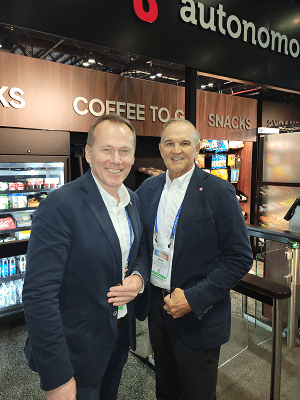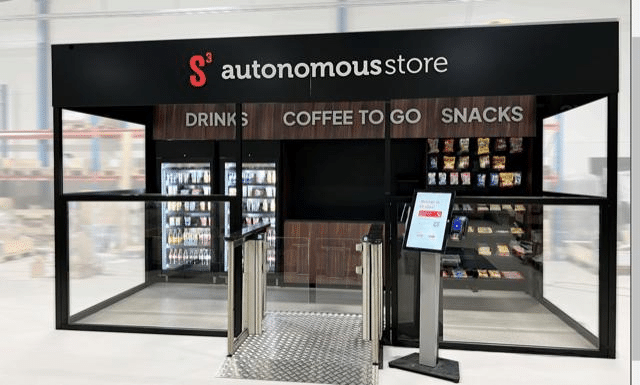Redbox Technology Creators Unveil Versatile Autonomous Micro Market
When Mike DeLazzer and his partners saw a future in video retailing beyond brick and mortar, they created the Redbox technology which is deployed in tens of thousands of kiosks.
Following similar observations in vending, DeLazzer and partners Kristian Silbvers and Franz Kuehnrich of Instant Retail Systems (iRS) are taking micro markets one step further, speeding up shopping time using weight-based transaction technology, sensors and cameras rather than just scanners to sell all products, including those on pegs and self-service coffee stations, in the micro market.
Instant Retail Systems has also developed a complete in-house custom back office and mobile application system which includes economic data transmission, product ordering, route management and warehouse product picking. DeLazzer said these additions make the offering a one stop shop for vending operators, enabling them to run a next generation market.
According to DeLazzer, the new iRS micro market is the only one with weight-based sensors on pegged products. Weight-based sensing with other markets, he said, are limited to shelved products.
At the heart of the iRS market is what DeLazzer terms grab and go retailing rather than scan and go retailing. With scan and go, the shopper needs to personally scan many items, either at a checkout kiosk or on a personal device. With grab and go, DeLazzer said the artificial intelligence of product weight and cameras does all the work and no scanning is needed.
DeLazzer said weight-based tracking enables a shopper to grab a handful of product, such as small candies, without scanning each item individually. The system can even sell items by the pound. Artificial intelligence knows how many units have been grabbed and records the selection to the shopper’s account.
Markets can be stocked with whatever product the operator wants to sell and are completely brandable to an operator’s needs. Micro market operators can create their own planogram and are not locked into purchasing stock from one individual supplier.
The new unattended market has been successfully deployed in Europe for three years with product shrinkage levels under 1%. The market will be unveiled to the North American vending market in Booth #1557 at the NAMA Show in Atlanta in May.
Here is how the system works. The shopper logs into the kiosk at the store gate. Once data is validated the gate opens. When the shopper enters, the system’s 3D camera converts the person into an artificial intelligence stick figure. Using a combination of the camera data and shelf sensors, the system puts product into the shopper’s virtual cart the instant it is pulled from the peg, grabbed from the cooler, lifted from the shelf or retrieved from a beverage brewer.
If the shopper decides to put the product back before the transaction is finalized, the system identifies where the item has been placed, even if it is returned to the wrong hangar or bin, allowing a merchandiser to promptly find the misplaced product and put in the proper spot the next time the micro market is resupplied.
When shopping is done the individual views the cart, authorizes the sale to the registered payment method, and exits the automatic gate.
As soon as the shopper leaves the store, so does the data. Real-time data is transmitted to Instant Retail Systems’ central database in the cloud or at the data center for as little as $10 per month enabling immediate decisions to be made. Operators can access the data at any time from their phone, tablet or PC to verify store inventory, change the planogram to help move product, check freshness of product and more.
The app can help route drivers more efficiently pick product at the commissary/warehouse and design the day’s drive. According to DeLazzer the software allows route drivers to be scheduled only to locations that need attention. He said since data shows 20% of an operator’s locations don’t need attention on a scheduled restocking day the software can save gas and employee head count. “Knowing exactly what product needs to be shipped to a specific location saves time and inventory,” he said.
DeLazzer likes to say that anything which has a weight can be sold in the iRS micro market. That means that one market could sell items as diverse as apparel, personal protective equipment, cosmetics and toiletries, fresh food, snacks, packaged beverages, drinks from dispensers and more.
For more information go to the company’s website, www.instantretailsystems.com, call 321-430-4055 or email info@instantretailsystems.com.









